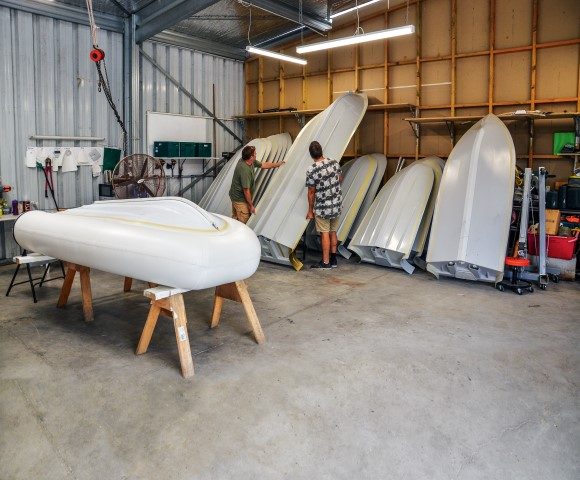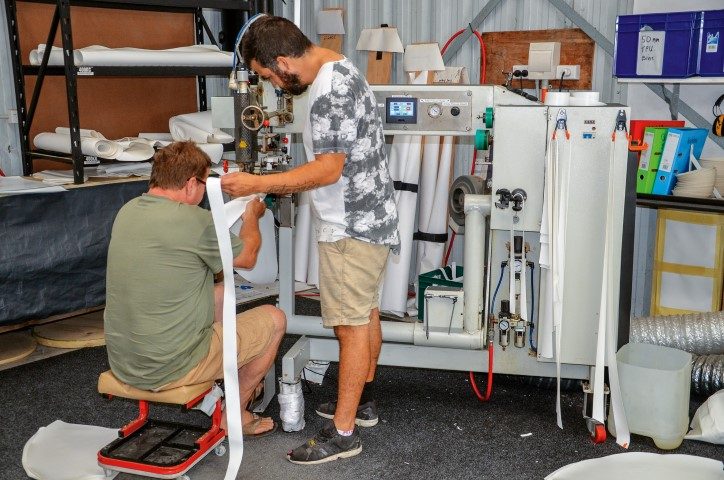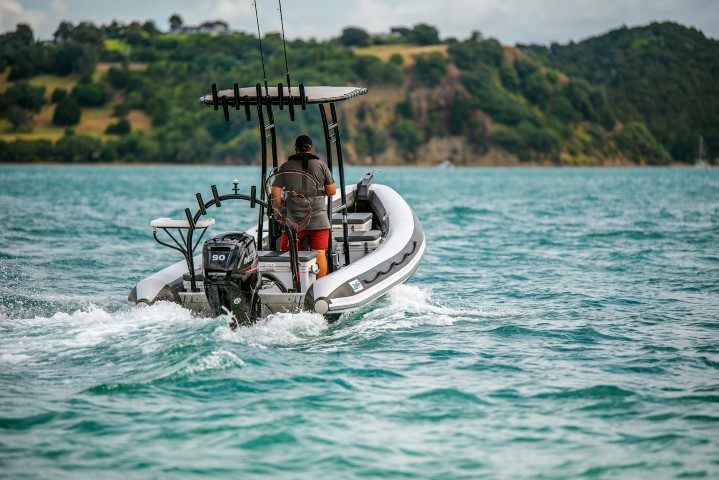

Seafarer managing director Neil Curtling has a lengthy track record in boatbuilding – and in RIB design and manufacturing specifically. Around 35 years in fact. So his thoughts about what makes a tough, robust RIB are worth considering.
And it’s the bonding system he’s developed for his inflatables’ tubes that is particularly interesting. He believes his Dual-Seal technology – where butt joins in the PVC/polyurethane tubes are welded both inside and outside – is unique in New Zealand, and possibly in the world. Conventional tube construction sees joins glued/welded on the outside only.
“I’ve customised a relatively standard heat-welding machine called a Seam Master – its feeder mechanism in particular – which allows me to weld the butt joins first on the inside and then on the outside, using reinforcing tape on both sides. This creates a really robust join.”

Over the years Curtling has witnessed the steady evolution of tube construction and gluing/heating/radio frequency (RF) techniques. “I’ve used them all in their various guises – and in my opinion heat welding offers significant advantages, especially when the joins are sealed on both sides.
“I think heat welding promotes greater consistency in the quality of the joins because you can see the joining process as it happens – you’re not relying on an ‘invisible’ bonding process or on ‘feel’. With heat welding, the integrity of the join is instantly apparent.”
He uses the German-manufactured Valmax PVC/polyurethane fabric for his boats – only in white for the PVC models, and light grey for the polyurethane tubes.

“As everyone knows, New Zealand suffers from pretty aggressive UV rays – more so than in other parts of the world – and a white/grey fabric is best for reflecting those rays. Black tubes invite trouble – and they eventually suffer from delaminated joins.
“In conventional glued joins, UV rays accelerate the ‘plasticisation’ of the fabric. The rays react with the glue, weakening it as well as fabric. The degradation continues and eventually the seams fail.”
In addition to manufacturing its own RIBS the company also manufactures tubes for a range of other RIB builders, including Auckland’s Smuggler Marine. Seafarer also has a division specialising in repairs to all brands of RIBs – with tubes constructed in PVC, polyurethane and Hypalon.
Curtling launched Seafarer Inflatables four years ago and to date his hulls (up to 3.4m LOA) are suitable for a maximum 8hp rating. But by adding a false floor to the RIBs, engines up to 15hp can be accommodated. A new model capable of taking a 30hp engine will be introduced later this year.

The alloy hulls are fabricated nearby, in Silverdale, by Hibiscus Sheetmetals. The components are cut by an outsourced CNC laser facility. The laser cut, says Curtling, delivers much better productivity and accuracy during assembly. Hulls are also pre-drilled before being powder-coated – to eliminate any possibility of bare aluminium being exposed to seawater.
With the rigid hulls manufactured off-site, the company can assemble around 40 boats a month. Curtling also offers a reasonable level of customisation to his designs – longer, wider, differently-configured centre-consoles. “Because we’re a small company, we’re able to accentuate flexibility and attention-todetail. I like to think we specialise in hand-crafted quality.”
All Seafarer RIBs carry a 10-year, fully-transferrable warranty.
For more information visit Seafarer Inflatables at www.seafarerinflatables.co.nz or call 021 570 505.
THE 6M SEAFARER
Currently, the Seafarer 6m RIB is the company’s largest build. With the luxury of starting with a ‘blank piece of paper’, Curtling brought his extensive experience and his personal wish list to the boat. The result is a well-founded and impeccably constructed all-round sport boat.
Pontoons are built from the German-manufactured Valmax TPU fabric. A double layer of fabric is installed on top of the pontoons in high-wear areas. It also offers additional protection from fish spikes and hooks. Numerous Railblaza star ports along the gunwale can be used for removable rod holders.

Hull construction is in 4mm marine-grade 5083 alloy and it includes a built-in underfloor 80-litre fuel tank. Particular about attention-to-detail throughout the manufacturing process, Curtling insists on using the same welding team for all his hulls to maintain quality and consistency. Welds are as clean as any I have seen – obviously the work of an experienced and competent fabricator.
Ultralon U-Deck flooring throughout provides comfort and grip. The cockpit drains through scuppers in each corner with duck bills preventing back fill.
Primarily designed for fishing, this RIB has great all-around access for casting. The black powder-coated alloy T-top provides good protection from the elements and plenty of rod storage. Curtling says it’s significantly lighter than the stainless-steel option.
Deck hatches reveal underfloor storage for large items. No less than four Icey-Tek chilly bins are installed for holding the catch, separate from food and drinks.
A 90hp Mercury four-stroke provides ample power, and its Spitfire X7 four-blade prop delivers plenty of bite. A tow bar mounted over the engine well caters for the water sports and wake boarding enthusiasts – and also provides additional rod storage. A waterproof Fusion Marine stereo provides the sound track.
The moulded centre-console unit is finished in a classy charcoal grey. It’s wide enough for two (standing) while underway. Twin batteries – house and start – live here on a shelf protected from any water ingress.
A polycarbonate curved screen provides good protection and visibility, with a robust stainless grab rail all round. A padded single seat is mounted on the front.
The foredeck area is generous, even with two Icey-Teks installed – plenty of room for two anglers to cast and very stable at rest. It affords easy access to the bow and the under-floor anchor locker. A robust glass bow sprit and stainless bow roller take care of the anchoring duties.
The rig rides on an Aakron single-axle trailer equipped with wobble rollers, Hella Marine LED submersible lights and a three-speed winch. Extra heavy-duty galvanised mudguards look like they could take some real punishment.
Kawau Bay was fine with a 10-knot southerly breeze providing a modest chop. We wondered if it would have been wise to pack a spray jacket. But our fears were unfounded. The large diameter tubes do a great job of deflecting spray. We had an absolutely dry ride on all angles to the wind.
Maximum speed, according to the Lowrance Hook GPS/plotter, was 30.5 knots. It felt solidly connected to the water and free of any handling vices. It turned in accurately with minimal prop slippage, even in aggressive turns.
A well-designed, solidly-built performer.




